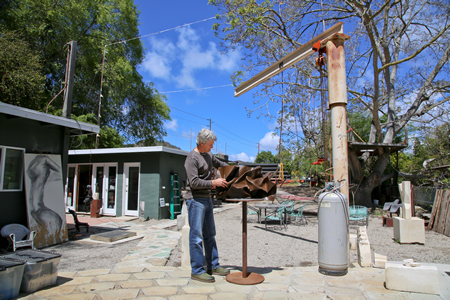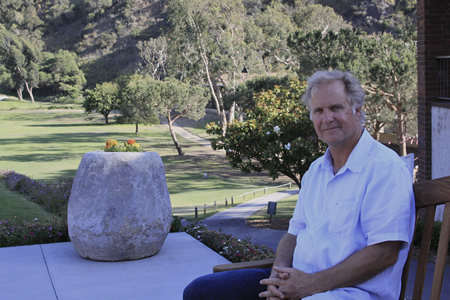By Jennifer Erickson | LB Indy
Two high profile local development projects held in limbo last year due to appeals by opponents move closer to resolution in 2015. The California Coastal Commission set hearings Thursday, Jan. 8, on sculptor Louis Longi’s artist work/live project on Laguna Canyon Road and Mark Christy’s remodel and expansion of The Ranch in South Laguna.
It remains to be seen whether the Commission, which convenes at the Santa Monica Civic Center, will agree with its staff, which recommends approval of both projects but sets long lists of conditions on the principals. While Longi has already agreed to comply with most of them, Christy’s initial trade-off proposals to satisfy Commission concerns came up short, according to the staff reports.

On Longi’s project, the Commission must first determine whether the appeal raises a “substantial issue.” If, as the staff recommends in their report, substantial issue is found, Longi’s project will be subject to a de novo hearing, meaning that the Commission will evaluate the project in its entirety for a local coastal development permit.
For the Ranch, the Commission already found substantial issues raised by an appeal and will now also hold a de novo hearing to consider sanctioning a coastal development permit.
The controversial approval of Longi’s project locally last April sparked a heated public debate on the direction of development in the canyon. The Coastal Commission received three separate appeals on the project before the month was out, from Devora Hertz, Jackie Gallagher and Audrey Prosser, and Roger Butow, according to the Coastal staff’s report.
The appeals raised 13 overlapping claims, which included the contentions that the multi-unit project would adversely impact the environment, visual resources, community character and water quality; and that it fails to comply with setback requirements based on its proximity to a “blue line” stream. This last contention, about the project’s proximity to and adverse affects on the waterway, proved the main area where the Coastal staff found grounds for the appeal.
Coastal staff found that city planners erred by failing to identify the significance of the stream’s habitat value and allowing a set back of less than 25 feet from it. Given those findings, Coastal staff also determined the project would set a destructive precedent if approved without conditions.
However, Longi has worked with staff to resolve those issues, including agreeing to remove proposed cantilevered decks that would have encroached on the setback, and to establish a five-year plan to restore and improve the riparian habitat within the setback area.
Based on Longi’s agreement to the conditions, the Coastal staff recommends approval of a permit.
The staff report notably found no issue with the proposed development’s potential impacts on views or community character based on its size and scale and determined that it complies with applicable development standards.
In one instance they pointed out that “the design of the proposed project is more rural in character than urban in that it provides large setbacks and open spaces between neighboring properties.” They also highlighted the fact that the proposed use as artist residences “reflects the historic character of Laguna Beach as an artist colony.”

On the Ranch, the appeal by Laguna Beach resident Mark Fudge contested a locally approved permit for renovations that include refiguring the hotel’s 64 rooms into 93, a restaurant makeover and a spa and fitness center addition on the 84-acre property in Aliso Canyon.
The appeal raised a myriad of issues including loss of affordable overnight accommodations, pedestrian access, parking impacts, historical preservation, impacts to biological resources and protection of water quality.
In reconfiguring the rooms, the hotel will effectively lose 32 more affordable rooms and gain 33 higher cost rooms, the staff report says. Intensification of use goes beyond additional hotel rooms with expanded assembly areas, a new spa open to hotel guests and the general public, and improved amenities, the report noted. These will heighten parking demand that could impact the surrounding area, including a public lot near Aliso Beach.
Though Christy proposed concessions — public access through the site for pedestrians and cyclists and limited small group camping experiences — Coastal staff described them as insufficient to address the project’s impact on public access and recreation. Instead, they included their preferred remedy in a list of 22 special conditions they recommended Christy agree to in order to obtain Coastal Commission approval for a permit.
Christy’s proposal for trail access – which he rejected as physically impossible and unsafe across the Ranch’s golf course during Planning Commission testimony last year – would involve creation of a hillside trail that would require obtaining private easements and other time-consuming complications. He therefore proposed a shuttle across the course until completion of the trail.
Coastal staff found the plan insufficient because Christy proposed that a third party take responsibility for trail development, with no guarantee of a final result. Similarly, the interim shuttle program he proposed did not guarantee funding and operation, the report said. Finally, the offer of overnight camping experiences would not sufficiently offset loss of affordable overnight accommodations since it only applied to nonprofit groups and would not be open to the general public.
To offset the loss of low cost rooms and public access, staff proposed that Christy either pay an in-lieu fee of $1.1 million ($33,970 for each of 33 units) or put more backbone into the shuttle, trail and camping proposals.
In the case of the latter option, staff proposed that Christy himself fund and operate a shuttle program from Coast Highway, dedicate an easement for a pedestrian and cycling trail, and commit to booking a minimum of 12 small group overnights annually at the former scout camp at the far end of the golf course.
Other conditions included parking space requirements, a valet program for events, restricting the fitness center to guest use, and replanting the scout camp area, as well as provisions for tree trimming and an archeological monitoring plan.




